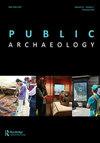The Dynamics of Heritage-Making at an Archaeological Site in South 24 Parganas, Bengal, India
IF 0.9
4区 历史学
0 ARCHAEOLOGY
引用次数: 0
Abstract
Archaeological heritage is seldom fixed in time. Heritage-making is an ongoing process deeply entwined with social/cultural memory and identity formation. These processes are traced through an archaeological monument, located in the Sundarbans, in the South 24 Parganas district of West Bengal, India. The monument, named ‘Jatar Deul’, is a brick tower, stylistically labelled as a rekha deul — a curvilinear tower with a cruciform ground plan —belonging to the Orissan architectural style. Its exact chronology is unknown, as is its creator, although it is stylistically dated to the thirteenth century ce. It has survived more in myths, legends, and local tradition than in historical sources. This paper explores how the monument becomes a site of memories and how multi-vocal identities are forged around the locus of the site, now revered as a sacred place of Shaiva worship. The Postcolonial State has only a marginalized presence and the main stakeholders remain non-professional archaeologists, local schoolteachers, and the local population living in close vicinity. Identity work at the site is no longer the archetypal Bengali/regional identity seen in the pre-independence context, but reflects sub-regional cultural/religious affiliations. This paper is the result of ethnographic research, particularly interviews, of select sections of the local community, focusing on the recent organization of an annual fair at the site, which has thrown up questions on archaeological tourism. On the whole, this study examines how an archaeological monument is shaped and formed in the present in contemporary South Asia.印度孟加拉邦帕尔加那斯南24号考古遗址的遗产形成动态
考古遗产很少能及时固定下来。遗产制作是一个与社会/文化记忆和身份形成紧密相连的持续过程。这些过程可以通过位于印度西孟加拉邦南24 Parganas区孙德尔本斯的一座考古纪念碑来追溯。这座名为“Jatar Deul”的纪念碑是一座砖塔,在风格上被标记为rekha Deul——一座平面图为十字形的曲线塔——属于奥里桑建筑风格。它的确切年代不详,它的创造者也是如此,尽管它在风格上可以追溯到公元13世纪。它更多地存在于神话、传说和当地传统中,而不是历史来源中。本文探讨了这座纪念碑是如何成为一个记忆之地的,以及如何在这个现在被尊为Shaiva崇拜圣地的遗址周围形成多种声音的身份。后殖民国家只有边缘化的存在,主要利益相关者仍然是非专业考古学家、当地教师和居住在附近的当地居民。该遗址的身份工作不再是独立前背景下的典型孟加拉人/地区身份,而是反映了次地区的文化/宗教背景。本文是民族志研究的结果,特别是对当地社区特定部分的采访,重点关注最近在该遗址组织的年度博览会,这引发了对考古旅游的质疑。总的来说,本研究考察了当代南亚考古纪念碑是如何形成的。
本文章由计算机程序翻译,如有差异,请以英文原文为准。
求助全文
约1分钟内获得全文
求助全文

 求助内容:
求助内容: 应助结果提醒方式:
应助结果提醒方式:


